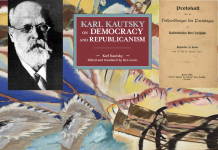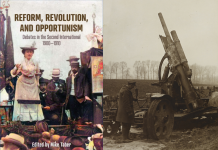Joe Sabatini assesses an important new work of Marxist theory.

Deciphering Capital is a long awaited work, which Alex Callinicos has been developing over a number of years. Although stimulated by the resurgence in Marxist political economy since 2008, the book essentially goes back to his PhD in the 1970s.
Principally, Deciphering Capital could be described as an attempt to go back behind capital. In particular the work is a painstaking explication of the difficulties Marx faced in disentangling the contradictions of Ricardo’s theory of political economy, and his use of Hegel’s Logic as a means to hit upon his own method of exposition.
What this means is that Deciphering Capital is not an introductory guide to Marxist political economy, or even to Capital. In fact any reader who is not familiar with Capital, or even Hegel’s Logic will struggle with this book. Yet it is a major contribution and for that reason I will try to describe the main course of his argument.
The book begins with a reconstruction of Marx’s manuscripts and the ongoing scholarly publication and commentary on these works. He then focuses on the central chapters on Ricardo and Hegel, before using the methodological insights gained to write a chapter on labour, value and crises. These chapters present a series concentrated debates with rival approaches and could be fruitfully disseminated in a more accessible format. The chapter on crises in particular puts forward a position on the relation between the falling rate of profit in the productive sector and financial bubbles which integrates rival schools while drawing on his reading of Marx. This could merit a review in its own right.
For this review I have focused on the central methodological chapters, as they lay the foundations for his overall argument, and will end with a brief review of the closing chapter ‘Today’. Here Callinicos makes his case for the relevance of his understanding of Marx for revolutionary socialists.
Capital as a social relation
Throughout this I have defended an interpretation of Capital that emphasises Marx’s understanding of the capitalist mode of production as a set of relations constituted by what I call… the two separations – that of workers from the means of production, giving rise to the exploitation of wage labour by capital, and that between capitals, from which arises their competitive struggle.
Callinicos, p. 297
By setting out from the treatment of capital as a social relation, Callinicos is asserting that we cannot understand capital except in terms of the mutual dependence of the two classes which constitute its primary relation – labour and capital.
In itself capital is nothing but the investment of money into the production of commodities which are realised on the market. However for capital to operate labour-power has to be bought and put to work by the agent that owns the money (the second point about labour-power being both bought and successfully expended is made forcefully by Bidet p.38-42).
The owner of money cannot function as a capitalist without hiring labour-power, and the labourer cannot exist without a job. This is the essential relation that constitutes capital.
It means that neither party can walk away from the relation without damaging the existence of the other. So if workers go on strike they are threatening the existence of the capitalist, and if the capitalists shut down the enterprise and invest elsewhere (or sit on their money) they threaten the existence of the workers.
The second relation that constitutes capital is that formed in market competition. Here capital is internally fractured, and so cannot operate as a single entity, but has to use the market to realise its initial investment in the production of commodities. While the relation of exploitation takes place within the process of the production of commodities, the relation of competition reacts back on this to confirm whether price of the commodity will cover the wages of the workers plus the surplus value.
This gives capitalism and Marx’s work on the system its two-fold structure, initial conditions that are determined in the production process, and final realisation that takes place in the market.
Yet we cannot jump from alpha to omega so simply. Each step between the process of production and competition has to be developed, so that the sequence holds. This was Marx’s central theoretical problem.
Confrontation with Ricardo…
Callinicos’ investigation centres on a critical moment in 1857, where a worldwide financial panic had broken out, and Marx was driven to examine questions of political economy in depth. His theoretical response was to write the Grundrisse, his first outline for a multi-volume project, which sought to develop a systematic conception of the capitalist mode of production.
Yet in order to start, Marx had to face a major crisis in the political economy bequeathed by David Ricardo.
Marx’s attraction to Ricardo lay in the latter’s commitment to the labour theory of value. This is the opening sentence to Ricardo’s The Principles of Political Economy:
The value of a commodity, or the quantity of any other commodity for which it will exchange, depends on the relative quantity of labour which is necessary for its production, and not on the greater or less compensation which is paid for that labour.
Ricardo, p. 5
In other words what regulates the value of a commodity is the cost of production, principally the length of time it takes to produce the commodity, and that this should be treated separately from wages (the compensation paid to labour). As anyone who has studied Capital knows, Marx will go on to utilise Ricardo’s separation of value from wages to show how a worker is paid less in wages than the total value they have produced. This insight formed basis for the theory of surplus value, and the basic social relation that constitutes capital.
It is here that difficulties began. Critics of Ricardo noted that changes in the prices of commodities in relation to one another are more likely to arise from competition than from the cost of production. Ricardo himself had admitted to a limitation of the theory of value in a situation where wages rise across the whole economy. Under these conditions he expected to see price rises in labour intensive industries, alongside a cheapening of commodities in capital intensive industries. The upshot would be a shake-up resulting in an overall rate of profit across the system.
For Ricardo’s critics this meant the admission of two incompatible theories to explain the relative prices of commodities. Either labour time created value, which was reflected in price, or price was independent of the cost of production and reflected the competition between wage labour and capital over the distribution of national income. Either way the rate of profit could only result from one of these not both.
At least that was where the argument rested and it led to an impasse which Callinicos describes:
The source of the impasse lay in the internal construction of Ricardo’s discourse. The labour theory of value provided an indispensable component of this discourse by providing a principle of value determination independent of wages and profits, which were treated as inversely related.
Callinicos, p.91
Callinicos argues that Ricardo’s empiricism lay at the heart of this impasse (p.91-3). Like most of his contemporaries, Ricardo had assumed that the role of theory was to provide general principles that are reflections of observable phenomena. So we can observe wages, profits and prices, but can we observe value? The answer is negative, but this negative relation between a theoretical object, like value, and an observable object like the price of a commodity was ungraspable in terms of Ricardo’s empiricism. At the highest level this meant that Ricardo had no theoretical basis on which to integrate all of the phenomena he observed.
Whereas Ricardo was cramming incompatibilities into his explanation, his opponents began to demolish the labour theory of value and replace it with explanations which focused solely upon the competitive nature of the market place (p. 85-6).
Marx saw clearly that there were two vital threats to the crisis in political economy. Firstly Ricardo had been right to seek a general theory that incorporated all observable phenomena, but secondly the failure of his synthesis had spawned a new model which would bury forever the key discovery of the labour theory of value.
The central methodological question Marx faced was to develop a coherent system that explained how capital was grounded in the labour theory of value, while also allowing for the full impact of competition.
…by means of Hegel…
For me the most important insight of Deciphering Capital lies in the notion that Marx’s primary confrontation was with Ricardo, and that Hegel was induced as a means to resolve a problem of logic.
For Callinicos, Hegel provided Marx with a way to break with the formal logic that dominated most schools of philosophy:
The old logic distinguished sharply between a universal concept and its particular instances. The relationship between the universal and the particular was an external one: the universal provided a principle for classifying the particulars, but remained an empty form imposed on the reality (the particulars) it sought to clarify… Thus separated from each other, the particular and the universal represent an obstacle: the classification of particulars in the absence of any attempt to articulate their inner structure does not deepen our comprehension of reality… Hegel advances as the resolution of the contradiction between the universal and the particular the concept of the singular, or concrete universal, in which the universal is the unification of the particulars.
Callinicos, p. 100-101
With the notion of singularity, Hegel provided Marx with a way to conceive of capital as a totality, in which the most universal features of that system are presented abstractly at the beginning, but are then filled in with more concrete particulars, or determinations. The internal structure of those particulars within the universal framework therefore constitutes the completed concept of capital. In other words we move towards the structure of the three volumes of Capital, which contain the full range of determinations constituting the extraction of surplus value in volume 1 through its circulation in volume 2 and on to the processes of competition, financing and distribution in volume 3.
We can see how Hegel’s tripartite formula of the universal, the particular and the singular was seized upon by Marx in 1857, when he was still sketching out the chain of determinations that would go into the totality of the capitalist mode of production:
Capital. I. Generality: (1) (a) Emergence of capital out of money. (b) Capital and Labour (mediating itself through alien labour). (c) The elements of capital, dissected accounting to their relation to labour (Product. Raw material. Instrument of labour.) (2) Particularization of capital: (a) Capital circulant, capital fixe. Turnover of capital. (3) The Singularity of capital: Capital and profit. Capital and interest. Capital as value, distinct from itself as interest and profit. II Particularity: (1) Accumulation of capitals. (2) Competition of capitals. (3) Concentration of capitals… III Singularity: (1) Capital as credit. (2) Capital as stock-capital. (3) Capital as money market.
Marx, p. 275
As a way of talking about capitalism, this still retains its punch 150 years on. If we asked a straw poll of people to describe capitalism, I reckon most people would begin with the money market, or the stock exchange, or possibly the banks, then they may think about firms, and wage labour would only pop up around the fringes – probably through discussions around zero hours contracts etc. What is fascinating is that this common-sensical view is the reverse of Marx’s method, because it begins with the singularity – the money market, which is in fact the end point of the whole explanation (as Callinicos will deftly show in his reconstruction of Marx’s theory of crisis in chapter 6).
But why should production and surplus value form the starting point and not the money market? After all this is precisely what critics of Ricardo called for. The reason Marx discovered was that capital is nothing without the inscription of wage labour in the very process of the production of commodities. Until that problem is cleared up the rest of the system appears to be based on self-creating money, or capitalists acting as ‘wealth creators’.
One of the great merits of Deciphering Capital lies in the painstaking way in which it traces Marx’s reformulation of a totality based on the extraction of surplus value, through a series of manuscripts (chapter 2 engages with the manuscripts and throughout they form the bulk of the quotes). This philological dimension is important as it provides the basis for a defence of Marx’s whole construction, particularly against free market economists, who would make an ideal target for a sequel.
… and beyond to capital as a mode of production
What is most fascinating about this book is that the Grundrisse forms just the beginning. There has been a vogue which sees this work as the true Marx, but I agree with Callinicos and the French theoretician Jacques Bidet, whose work Callinicos is heavily indebted to, and has produced one of the most thought provoking readings of Capital. For they see in the Grundrisse the site of Marx’s confrontation with Ricardo that frees him up to do something unprecedented.
Between the drafting of the Grundrisse in 1857 and the publication of Capital in 1867, Marx continued to reformulate the progression of determinations that went into his construction of capital (Callinicos provides a wealth of citations throughout the book). Key to this continuous reformulation was a step by step abandonment of his reliance on Hegel’s logic (p.123-4) and towards the realisation of the basic methodological formula that he developed in the introduction of the Grundrisse:
The method of rising from the abstract to the concrete is the only way in which thought appropriates the concrete, reproduces it as the concrete in the mind. But this is by no means the process by which the concrete itself comes into being.
Marx, p. 100
The first sentence is pure Hegel and is justly famous, but the second is the point where Marx leaps into the terrain of historical materialism.
Hegel’s goal in the Logic was to set out from the most basic category of being, and, through a series of negations, to arrive at a completed notion of the concept which would contain being and all of the determinations that make up being. Not only was this an eternal construct, in that it seeks to describe the way in which the world exists and how it can only exist for thought, but its completion was nothing but a process of returning with an enriched conception of what was inertly there from the start.
As Callinicos shows throughout chapter 3, Marx breaks with this. By asserting the prior existence of the world in all its material determinations, and that because these determinations are firmly embedded in time and space, they are subject to material transformation and to wholly new content that transform what was there initially. Capital is therefore not an eternal set of relations, but a new form of social organisation, which is building itself historically and geographically. This meant that the categories Marx needed to shape the concept of capital had to be developed through a process of externalisation, where each category is invoked to explain ever more complex situations that can be observed. So the observation that value does not immediately affect price movements required the introduction of categories that would link the underlying and invisible process of the production of value to observable determinations such as the interest rate, which affects the rate at which capital needs to repay its loans.
This meant that although the concrete for Marx had ontological priority, epistemologically, he began with the abstract as a means of grasping the most basic relationships that form the concrete – hence the concrete rising out of the abstract. It was at this point that Marx resolved the crisis of Ricardo and moved beyond Hegel to the point where we have Capital.
Today – lessons for revolutionary socialists
The final chapter titled ‘Today’ is the most readable, and applies the ideas developed in the main body of the book to the world around us. The chapter begins by establishing Marx’s project as a way of treating capitalism as a globally developing system with real world transformations in the way in which labour-power is exploited, and profits realised and distributed.
Callinicos demonstrates in this chapter the theoretical challenge which Marx confronted in his own work, that of integrating contemporary developments that appear to cancel each other. The two tendencies he focuses on are the continued expansion of the world working class, and financialisation.
Callinicos shows that the integration of these two tendencies into an overall explanation is critical, and essentially replays the challenges Marx faced when explaining what was going on in 1857. By tracing Marx’s process of overcoming the theoretical impasse of his times, Callinicos is able to present an approach we can use today through the primary and secondary separations of exploitation and competition:
The first separation (capital versus wage labour)… has explanatory priority over the second (competition between ‘many’ capitals), but what emerges from Marx’s constant reformulation of his categories across successive manuscripts is that both are necessary in order to grasp the laws of motion of capitalism.
Callinicos, p. 297
For revolutionaries this puts paid to notions that capital can live on immaterial labour, or that money alone creates money. Rather what we are witnessing is a complex integration of value production through science, information technology and increasing reliance on transport and logistics, which is placing greater pressures on both the realisation of profit via sales, and the sourcing of finance for investment. Rather than leading to the breakdown of the law of value, this simply places value where it always was, at the centre, in the ‘hidden abode of production’.
For revolutionary socialists the main lesson of this work is that if we are to tackle the challenges thrown up by contemporary capitalism – global inequality and climate change being two of the greatest – we must begin from the standpoint of capital in production. This means tracing the contours of the contemporary working class and then relating them back through the wider society, until we can connect up workers producing value to the mass of humanity whose ultimate interests lie in a world beyond capital.
Bibliography
Bidet, J. (2009), Exploring Marx’s Capital: Philosophical, Economic and Political Dimensions (Haymarket, Chicago)
Callinicos, A. (2014), Deciphering Capital: Marx’s Capital and its Destiny (Bookmarks, London)
Marx, K. (1973), Grundrisse (Pelican, London)
Ricardo, D. (edition undated), The Principles of Political Economy (Dent, London)




















[…] http://rs21.org.uk/2014/09/25/behind-capital-review/ Marxists waste too much energy on Capital: the book is taken as a sacred text and subjected to the humbled treatment given to esoteric wisdom. There is a much simpler approach: take the work as emblematic and leave it at that: the text’s theory attempts the impossible. Anyone who embarks on an ambitious project that suddenly starts to fall apart in execution can see what happened to Marx: he could not fully realize the vision of theory that animated the beginning. It would be better for the left to stop obsessing over the work, and use it as set of symbols or problems under study, refocusing energy on the sage of Marx/Engels starting in the 1840’s. It is time to stop setting up beginners for refutation by indoctrination in the now settled dogmas of marxism. Having written WHEE (history-and-evolution.com) I know from experience the problem that Marx bequeathed to himself in the ambition to create a master theory of history: the theory doesn’t work, first because history is ultra complex with multiple components beyond the economic, second because science won’t work on history taken as physics, free agency blocks a basic theory, and finally related to the first is the failure of economic processes to generate a macro dynamic: economics is a subsection of the whole, no more, no less. The issue of ideology therefore is rather that economic subsystems of society foist their obsession on the minds of social agents, making them overestimate the place of economy, in the process using theory to disguise their motives. In the actual time of Marx the theory of darwinism was rapidly assuming just such a role in the emergence of social darwinism. In any case of the super and substructure doesn’t really work. And it is good the theory doesn’t match reality, because the core of marxism hides its despair that the capitalist juggernaut is inevitable, the very illusion that was to be dispelled. […]
Hi Dr Tad. He does though it is woven into the text, and if you read Bidet’s book it goes into this at length – to anyone seriously into this I would recommend reading both books together. I agree that the real abstraction of labour and the whole notion of concrete and abstract labour was one of Marx’s most hard won insights. So thanks for bringing this up.
Thanks for the review. Does Alex have anything to say about how Marx breaks from Ricardo’s LTV by drawing out the implications of the real abstraction of labour? This seems to me to be a key issue, but you haven’t mentioned it here.